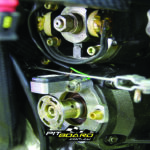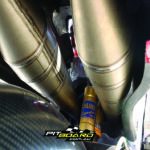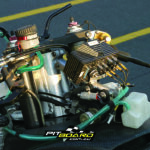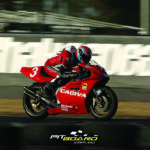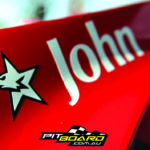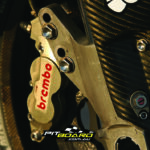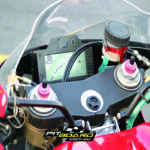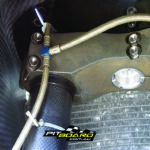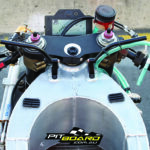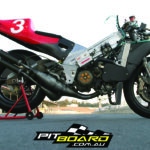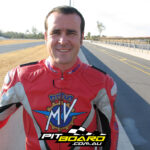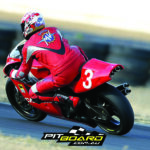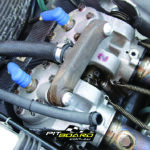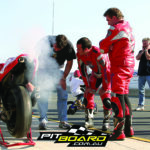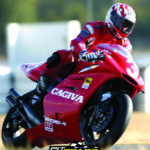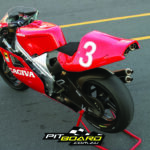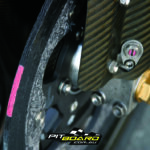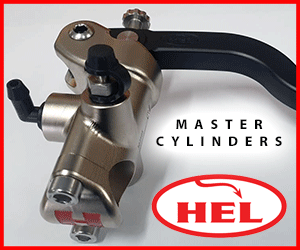This world famous Cagiva V593 belonged to huge motorcycle fan and avid collector, Steve Byrne. The bike held a spot at Steve’s bar with Andrew Pitt’s world title winning ZX-6RR. Steve’s other 18 bikes live in the garage locked up tightly. Just over a decade ago, Jeff rode it!
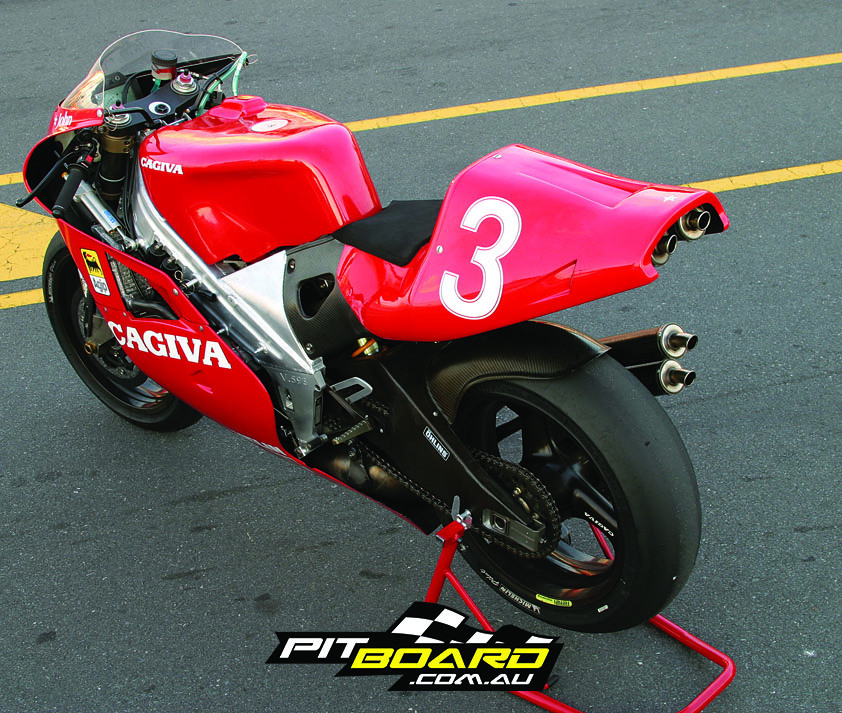
When Steve heard that Paul Feeney, the then importer of MV Agusta in Australia, was selling the V593 that John Kocinski won the US Grand Prix at Laguna Seca in 1993 and the Australian GP on in 1994, Steve just had to have it. Naturally, when Steve offered me a ride I didn’t hesitate in saying yes, I could not get on a plane quick enough. I think this is the first time I’ve felt true fear from a motorcycle.
Check out our other racer tests here…
The bike is invaluable and has a lot of important history. Cagiva entered Grand Prix racing in 1990 and had to battle against the ultra rich Japanese manufacturers that had seemingly unlimited budgets in days when expenses and rider salaries were peaking. Still the small factory with the big heart pushed on and eventually, against the odds, rose to the winner’s podium. Some believe that the odds of them winning a world title was more than likely, had finances not restricted the forward progression.
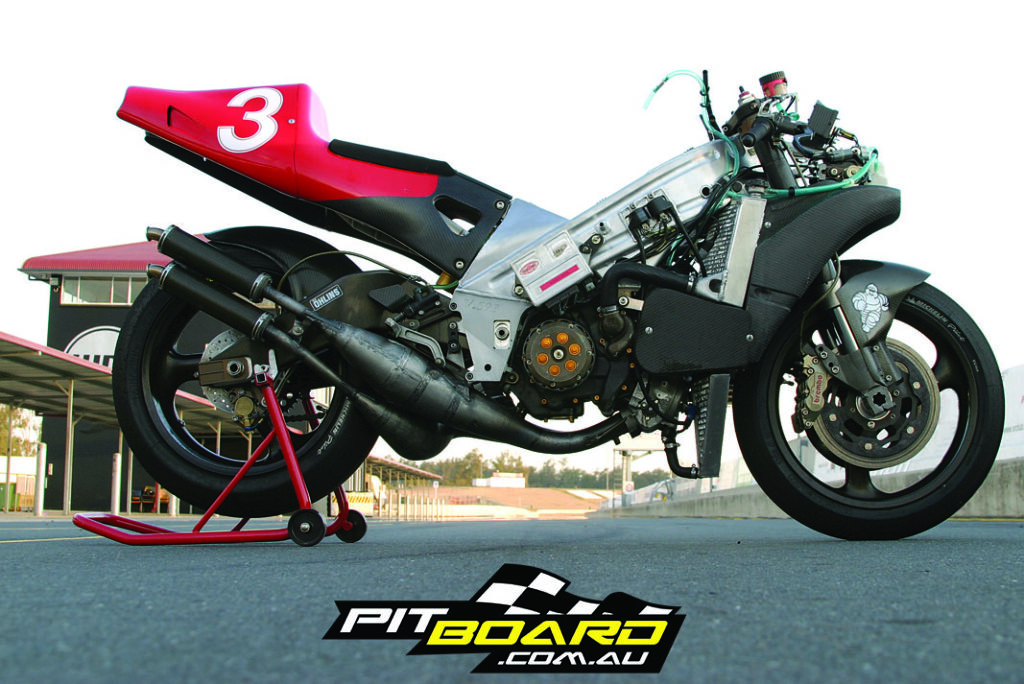
Eddie Lawson gave Cagiva their debut victory on a drying track in the 1991 Hungarian Grand Prix. Lawson left Cagiva before he retired from racing but other stars were drawn to the passionate Italian team with Randy Mamola, Mat Mladin, Doug Chandler also riding the bike at one stage their careers.
But it was the determined and highly talented John Kocinski that gave Cagiva the most champaign, winning at Laguna Seca in what was to be the final grand prix in the USA for 12 long years. After completing the season on the updated V594 John finished the 1994 championship in third position but sadly that was the end of the line and Cagiva went broke.
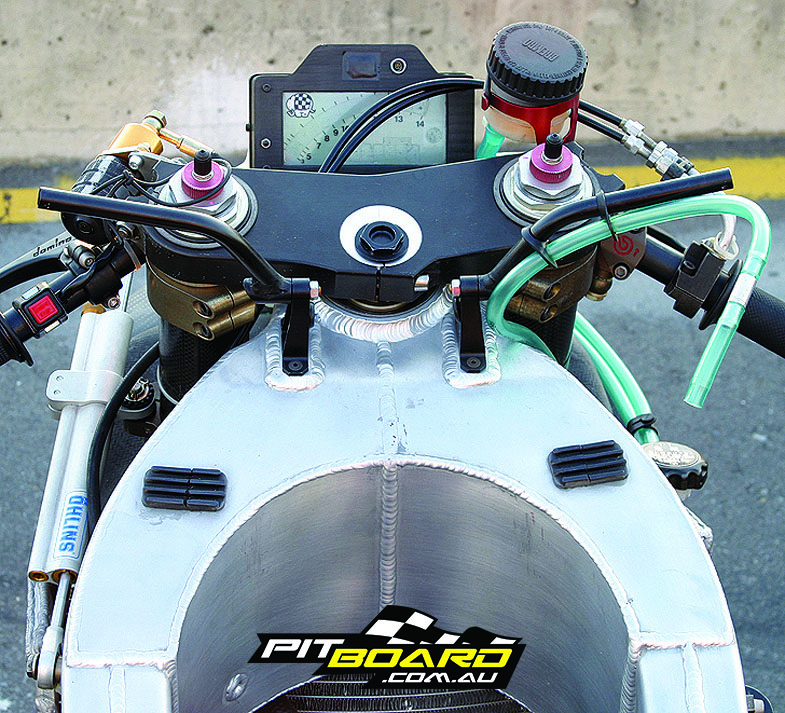
The Ride
I’m pacing around nervously as the bike gets warmed up by the legendary Dick Smart, it is a nerve wrecking time as it is probably the most expensive bike I may ever get to ride. Daryl Beattie obviously picked up on my panicked pacing. “Just stay relaxed and ride it normally. It’ll just feel like a superbike, only faster and lighter. Watch those carbon brakes until they’re up to temp,” Daryl Beattie, along for a ride, reassures me in that weird way a surgeon reassures you before cutting your chest open with a hacksaw, “Keep an eye on the temperature too and watch the powervalves, they seem to be jamming up a little at 9500rpm”…
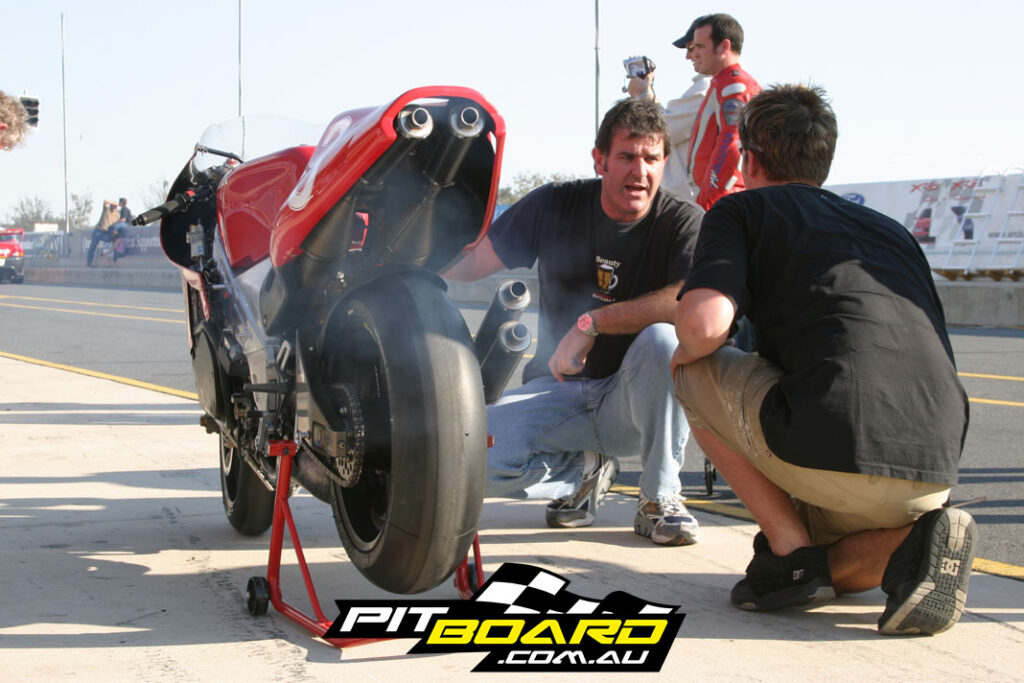
The next minute I’m being pushed down pit lane by ex Mick Doohan GP mechanic, Australian Dick Smart, just like the professional riding you see on the TV. I let the clutch out and the V4 fires into life. The racer comes out in me almost straight away. I’ve already got my knee down by turn two.
The first run down the back straight of Queensland Raceway I short shift and load the bike up, holding the throttle open in third gear to clear it and after a few coughs the digital tachometer suddenly screams past 9500rpm. I can feel my shoulder joints pulling apart as I shift at 12500rpm before grabbing the brakes for turn three, they felt just like normal brakes in that moment due to them still being cold.
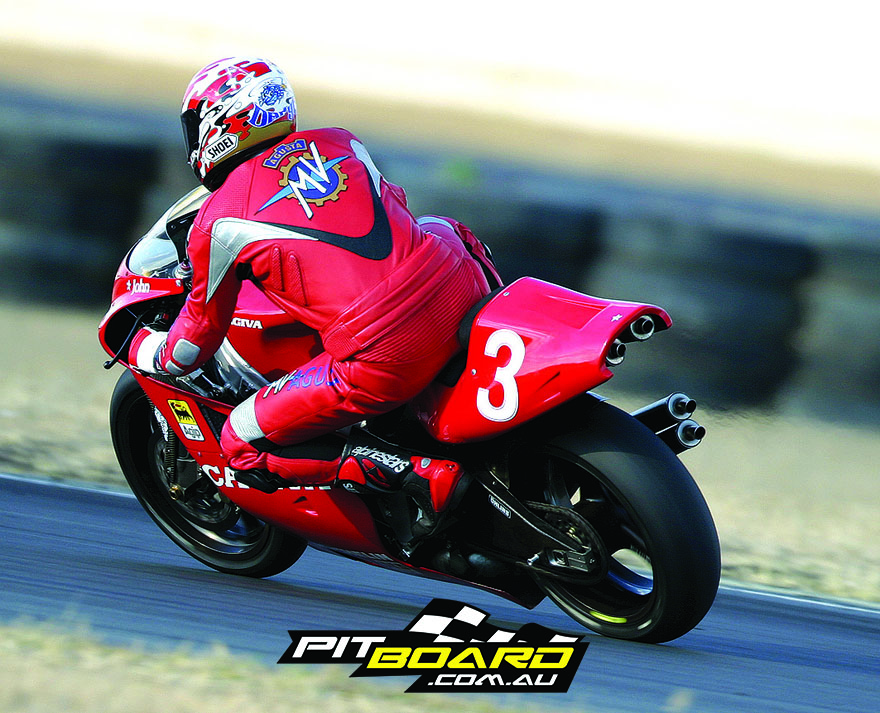
Out of turn three I feed the throttle on slowly to lean the engine out a little and get through that rough patch at 9000rpm. Again, the engine clears its throat and I’m struggling to hold on, let alone keep the front wheel down. All I can feel is wheel-spin then the front wheel lifting up, this thing hammers. I’ve never felt acceleration like it, not even on a turbo or a World Superbike or drag bike.
I’m cautious through the two left-handers on my first time around but I feed it on a little on the short straight before turn six, just to get a feel for the power delivery. Onto the chute for the first time the engine coughs again but once it clears, the bike explodes in a surge of acceleration and shifting through the ‘box via the electronic reverse-pattern quick-shifter delivers a feeling like no other. Nothing feels like this – no four-stroke could be this exciting.
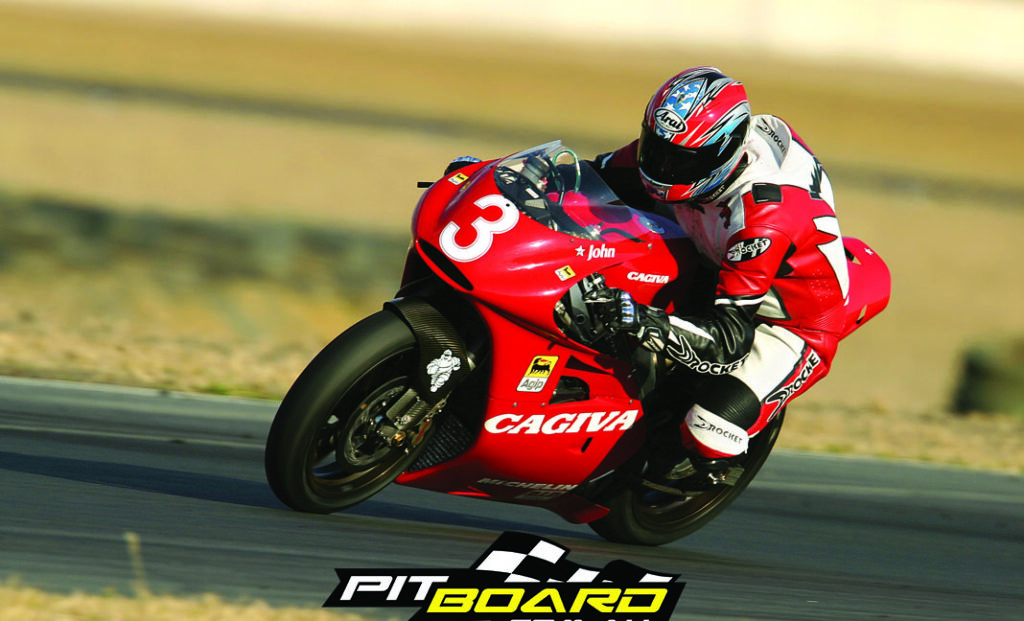
I feel like the Cagiva GP500 has knocked 20 years off my age, I’m 20 and fearless again. I squeeze the Brembo front brake lever at the end of the straight. One finger is all it takes but I have this picture in my head of the rotors suddenly getting up to temperature and locking the wheel before I can modulate the pressure. But soon I’m trail-braking into corners and I’ve got the hang of feeding the power on progressively out of the turns. I can’t believe how much concentration this bike is sapping from me.
The Dunlop tyres are up to temperature now and with more confidence in them, I’m pushing the Cagiva further and further on its side every lap. But I’m more than aware that I need to stand the bike up as much as possible before opening the throttle. Make no mistake, this ain’t no proddie or 600. Wind it on mid-corner on this thing and I’m going to be flying pretty high.

The chassis is ultra-stiff and the bike is so light. You’d really have to have an intimate relationship with the machine and a lot of laps under your belt to decipher confidence-inspiring feedback from it. Once you knew the bike, though, it’d be a brilliant talker. In my short session I was just relying on my past experience with slick tyres and knowing how far to push them at my very moderate pace.
The rear Ohlins GP-spec shock is predictably stiff and, to be honest, probably in need of a service after sitting around for so long, especially with my weight on it. The front suspension action is firm but nowhere near what I’d imagined. In fact the machine is riding the nasty bumps at Queensland Raceway quite well, with the exception of getting air over the bumps at the end of the main straight.
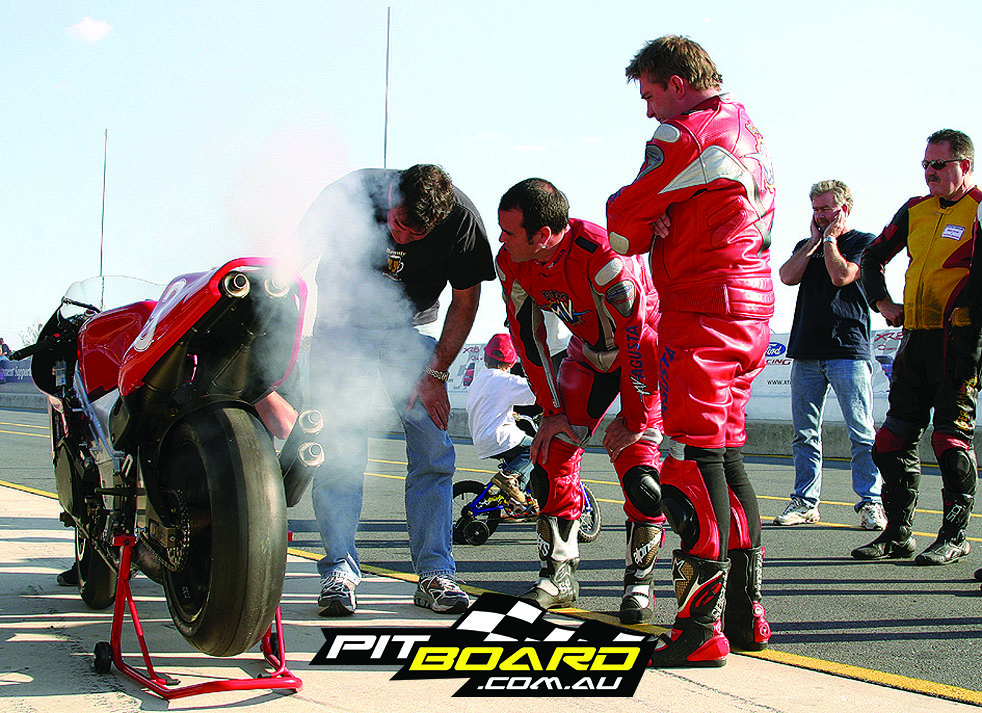
The session is coming to an end and my dream is almost over, just as I start to get smooth and comfortable, I put in what I feel are a few half decent laps about as quick as I could go on a stock 1000cc roadbike.
Not surprisingly the V593 feels better the faster I go and on the last lap I do just what Daryl said. I ride it like I’d ride a normal bike running into the turns fast, standing it up and winding it on harder and taking it right through to 13000rpm, 1000rpm short of redline. On the last lap I feel like I’m detached from the world. Like I used to feel when I was on a hot lap and in my ‘groove’ in my racing days.
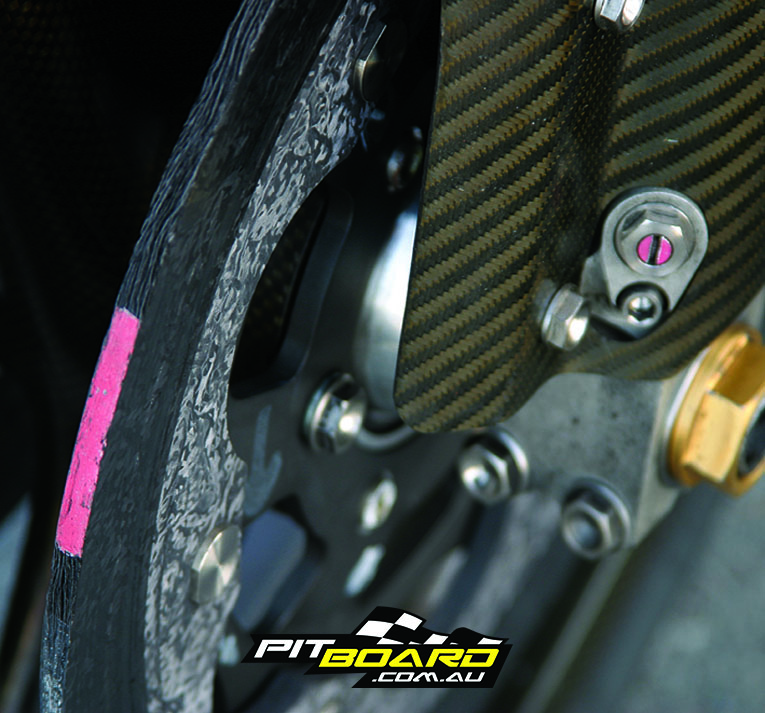
No bike has made me feel like that since I stopped racing and I don’t think anything else ever will. I think I’m in love. I ride back into the pits and hop off the bike feeling eerily calm and sedate. The 1993 Cagiva GP500 represented the pinnacle of the Italian firm’s 500cc Grand Prix competitiveness. It was passion and drive that got them there, however, a World Title was not meant to be as they ran out of money soon after during the following season on the V594 version, the last of the GP500.
World Champion John Kocinski Talks
Sitting down with the legendary John Kocinski, I got to learn more about the bike that had a short lived life in GP racing but a long lived legacy. John spoke about the team’s passion and excitement that surpassed the want to make money out of the sport, which is what motor racing should be about.
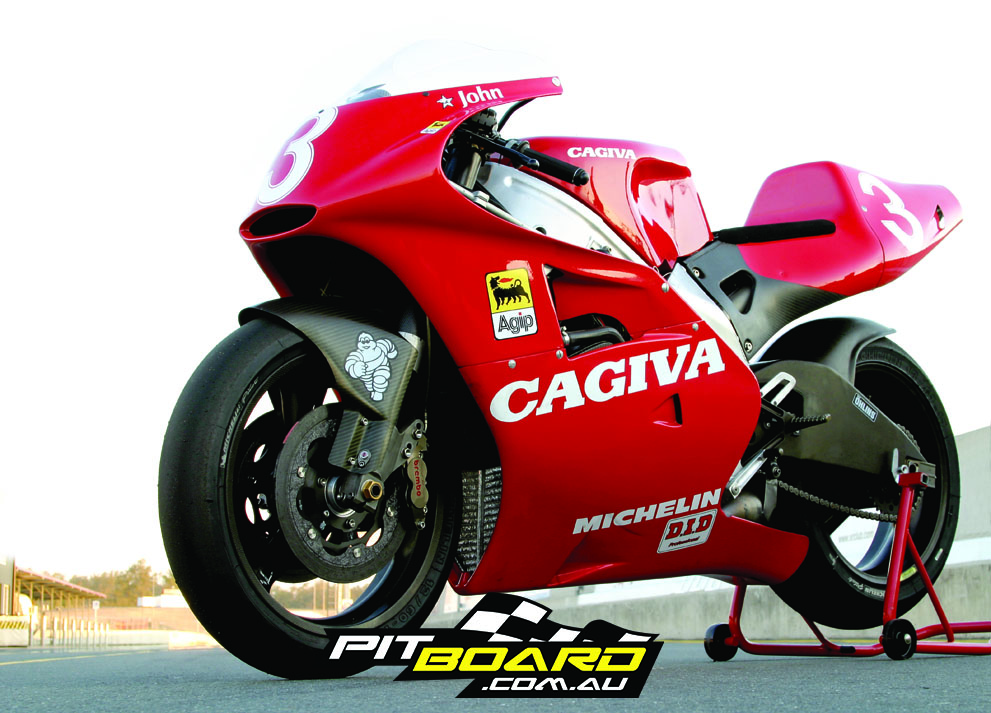
JW – It has been said that this was the bike that turned Cagiva from also-rans to almost wins and if you didn’t take the ride Cagiva would have pulled the pin. What is your take on that?
John Kocinski – Yes, it is probably true but a lot of my greatest memories have been when I rode for Cagiva. It was a company of great passion.
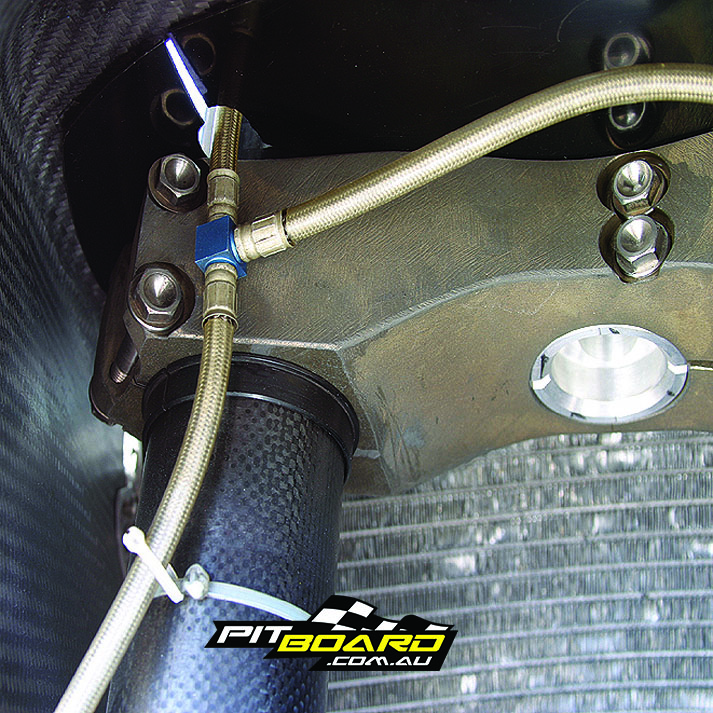
JW – When you think back on the V593 and V594 and the results, particularly the wins you achieved on the bike how do you feel?
John Kocinski – It is one of my greatest accomplishments to win on a machine that no one else other than Eddie Lawson has won on. It was heartbreaking when Cagiva could not continue in 1995 because we were so close to having a machine that could win a World Championship.
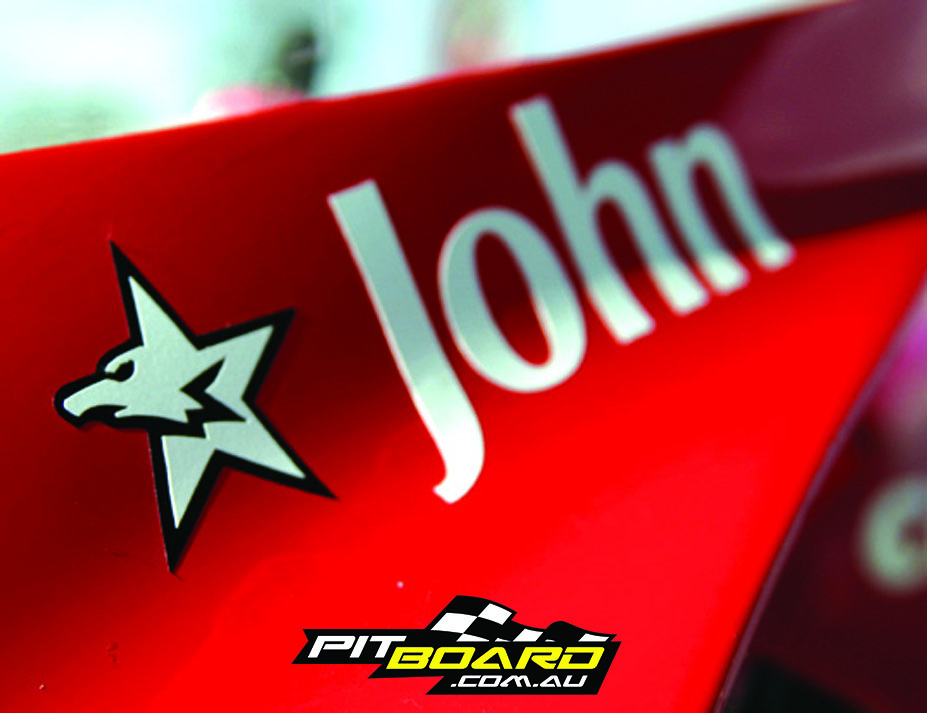
JW – How much of the work, in development terms, was done when you arrived at the team?
John Kocinski – Obviously, there had been work done, but it was far from complete.

JW – What were the strengths and weaknesses of the V593 and V594?
John Kocinski – The strengths were the agility and steering. The weakness was the power band.
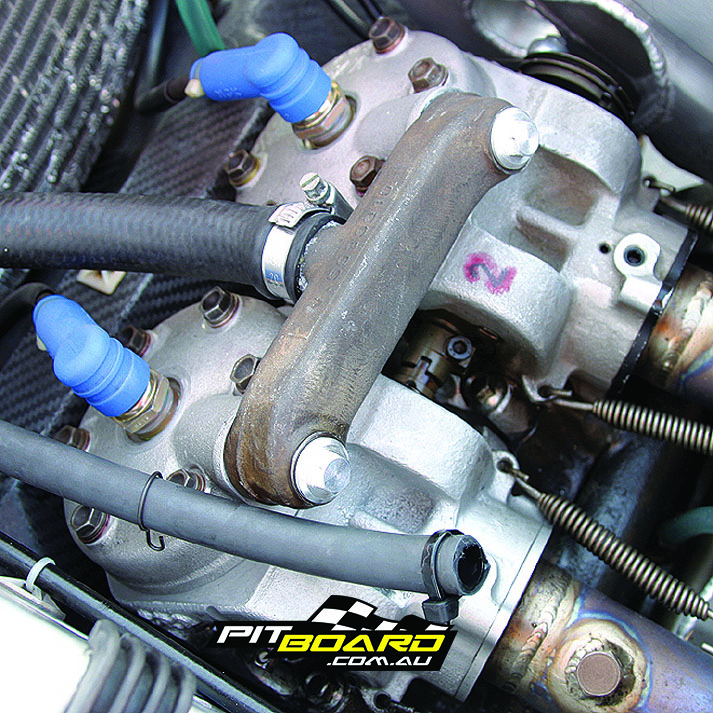
JW – Was this motorcycle capable of winning the title?
John Kocinski – Yes, most definitely.
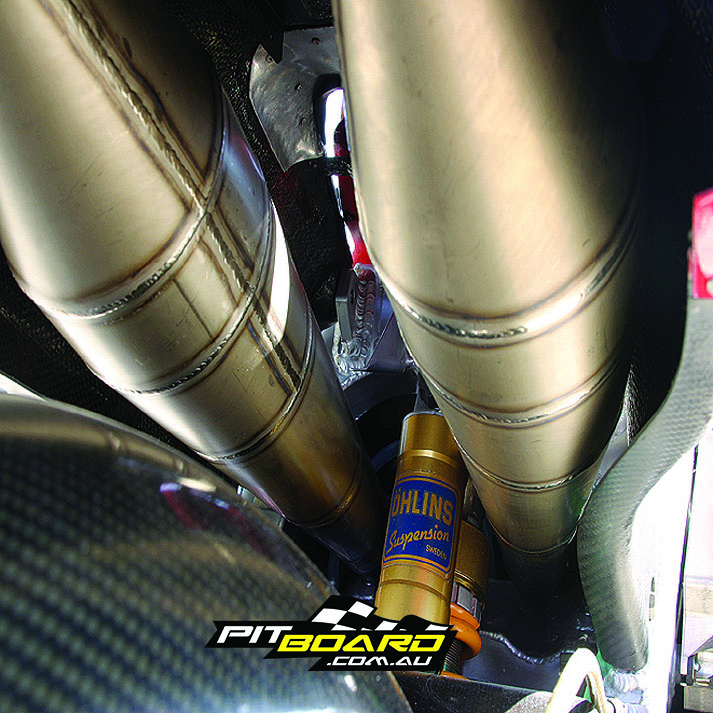
JW – Were you keen to stay on for 1995 if the team had survived?
John Kocinski – Absolutely. I loved the team, the engineers, I had great mechanics. It was just a matter of making some small improvements to the power delivery and handling.
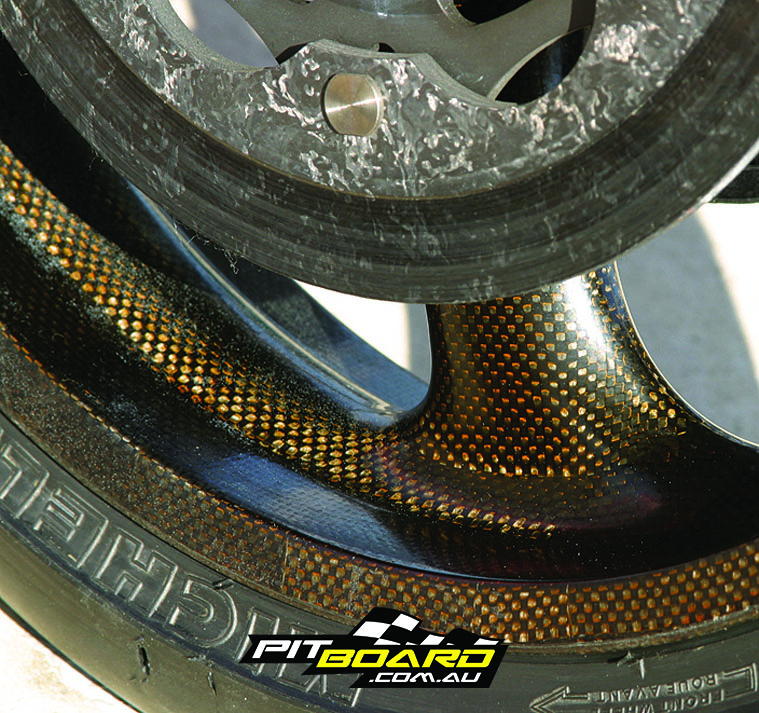
JW – Daryl Beattie said that overall he rates the bike well and that both yourself and Eddie Lawson proved that it is a reasonable motorcycle. But were you guys over-riding to compensate for lack of performance or was the bike really that good?
John Kocinski – No matter what machine you ride there are always issues. But definitely in 1994, the machine was the best it had ever been. I think the results say the same.
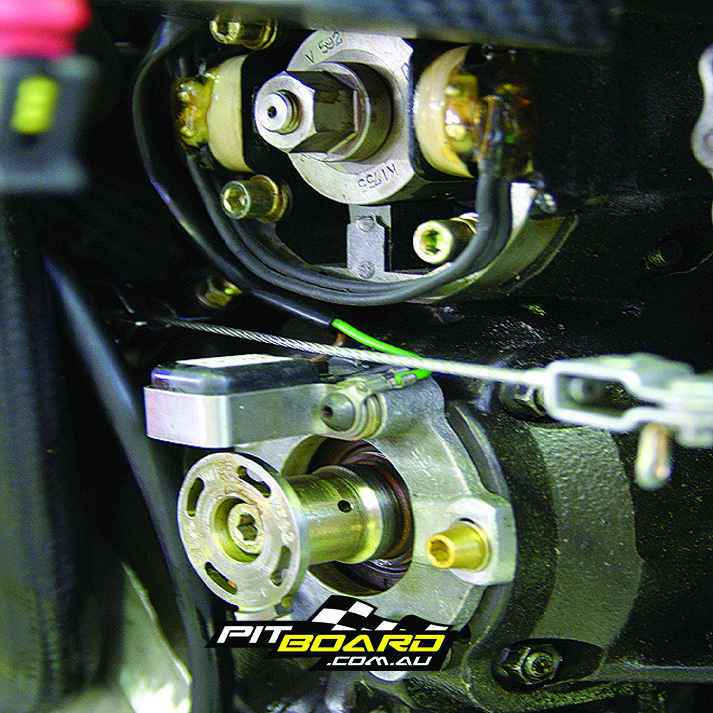
JW – What did it for you with 500s – the challenge, the acceleration, the adrenaline or the fear?
John Kocinski – That’s exactly what does it, I think, for everyone. The challenge, the acceleration, the adrenaline and fear.
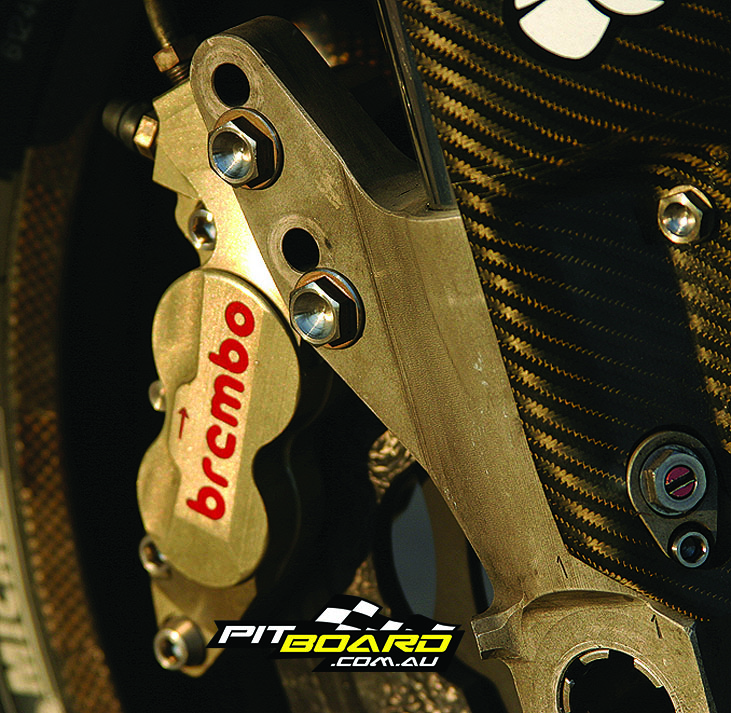
JW – Give us one word that sums up the Cagiva.
John Kocinski – Passion.
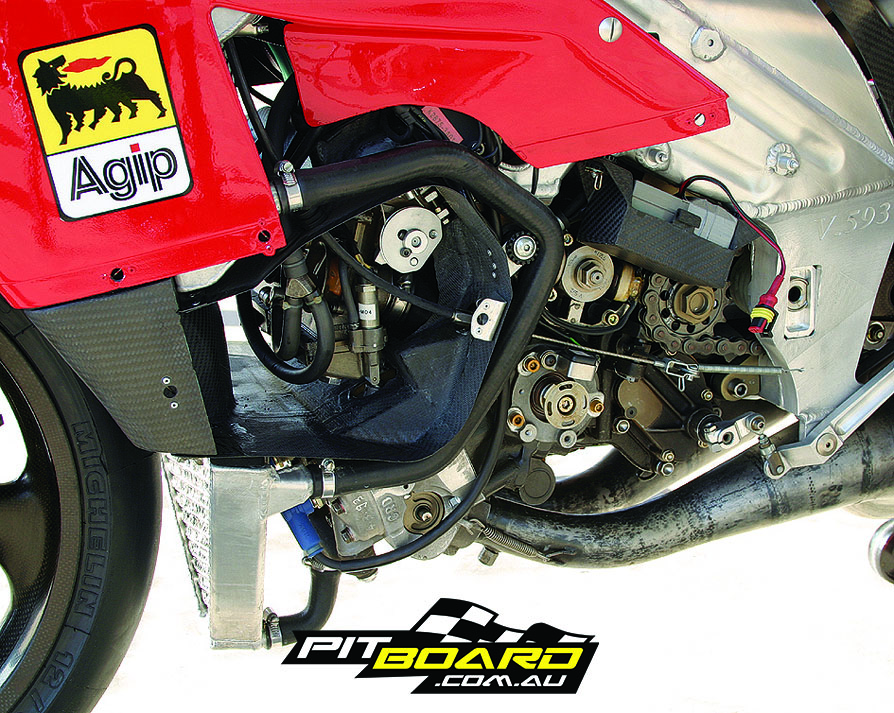
500c Legend, Daryl Beattie Chat
Catching up with ex 500 GP racer, Daryl Beattie, after his laps on the Cagiva, it’s safe to say that he’s hooked again despite not riding a 500 GP bike since he retired back in 1997. There were some similarities between the motors on the Cagiva and his old Yamaha but the frame was a new experience for Daryl. “That’s the most fun I’ve had since I retired in 1997,” declared Beattie as he tried to wipe the smile off his face after leaving blackies all over Queensland Raceway on the V593 Cagiva GP500.
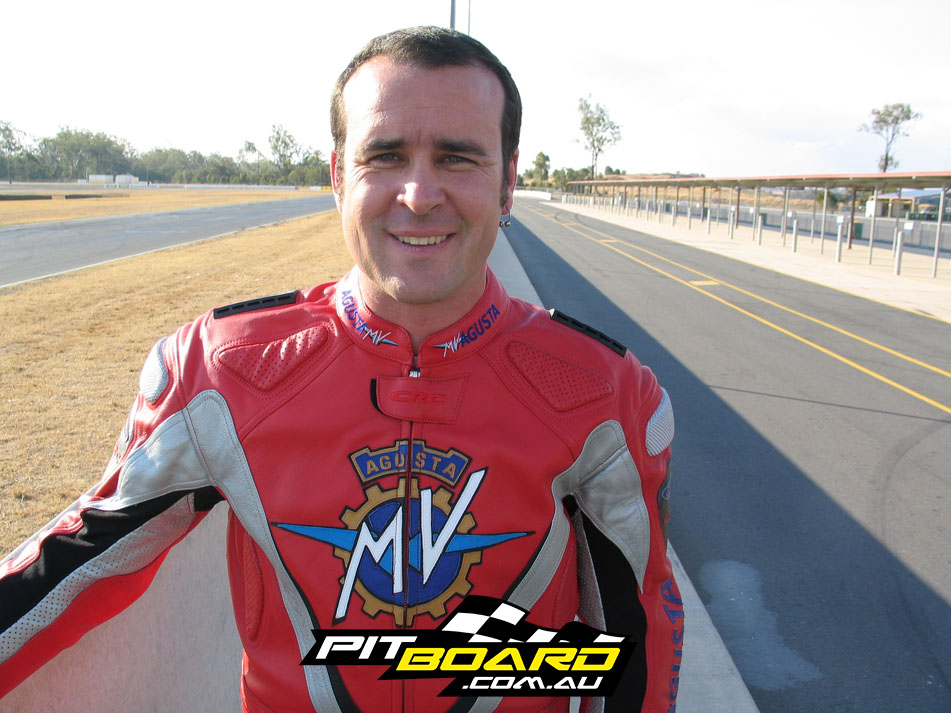
“That’s the most laps I’ve done on a track for years. I’ve only done those commentating laps at Australian Grand Prix but as soon as I left pit lane all the memories of 500 GP came back. Nothing beats a 500.” Admitted Daryl, “I felt good on the bike and it all started to come back to me.
“I remember this bike well and always wondered what it would be like to ride. It feels similar engine-wise to the Yamaha I rode in 1994 but it handles better. It’s really sweet and the carbon brakes are just awesome when you haven’t used them for a long time”.
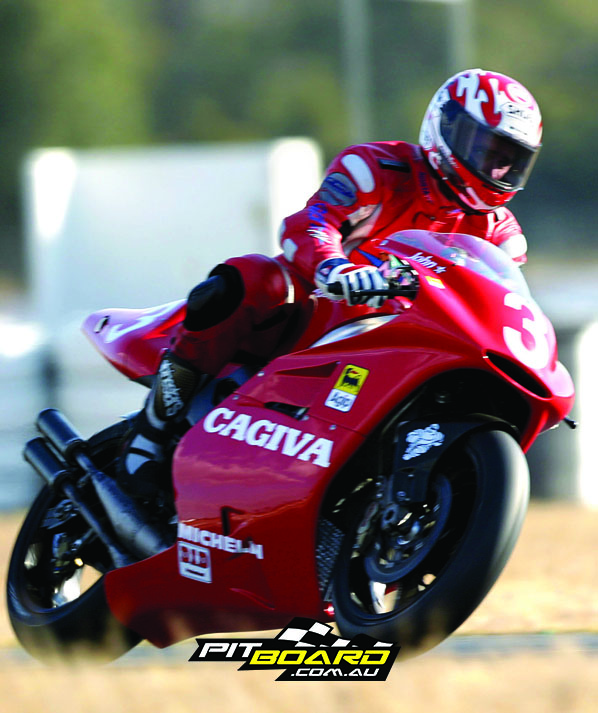
Daryl says he always knew the Cagiva was a competitive machine in the right hands, “The King (Eddie Lawson) did a lot for Cagiva and Kocinski had some good results on the bike. There’s no doubt that it had more potential so it is a shame that this was the second last one.”
“It feels really good to ride a race bike again. You just can’t beat the way they steer, stop or accelerate. The thing just wants to wheelstand in every gear. Unreal…. I’ve gotten a taste for it again so I’ll have to talk Mick (Doohan) into coming out to some ride days with me”!
1993 Cagiva GP500 V593 Specifications
POWER: 195hp@12600rpm
TORQUE: 75.5ft-lbs]@12000rpm
WET WEIGHT: 130kg
FUEL CAPACITY: 21 litres
ENGINE: Liquid-cooled, 80-degree V4, twin crank, two-stroke, 56 x 50.6mm bore x stroke, 498cc, two twin-choke 36mm electronic power-jet flat-slide Mikunis, crankcase reed-valve induction, pressurised airbox, titanium expansion chambers with carbon-fibre mufflers, electronically controlled cylindrical power valves – five transfer, three exhaust, electronic ignition with programmable advance curve linked to throttle opening, exhaust powervalve and carburettor power jet, NGK plugs, single plain piston ring pistons, needle roller small-end and roller big-end bearings, straight-cut gear to clutch from right-hand end of lower crank
GEARBOX & CLUTCH: six-speed cassette-style, ten possible ratios for first and fourth, seven for second and fifth, nine for third and sixth, drum selection, electronic quick-shift, dry multi-plate, seven friction and six steel plates, six springs
CHASSIS: Twin-spar aluminium with adjustable steering angle, carbon-fibre swingarm, Wheelbase: 1390mm, Rake: 23°± + 1 degree, Trail: 95mm\
SUSPENSION: Fully adjustable inverted carbon-fibre Ohlins forks, Ohlins fully adjustable shock
BRAKES: Twin 320mm carbon-carbon front rotors, Brembo four-piston monoblock calipers and Brembo radial master-cylinder, Brembo pads, single 190mm carbon-carbon rear rotor, Brembo twin-piston monoblock caliper, Brembo pads
WHEELS & TYRES: Ferrari hollow-section carbon-fibre wheels, 3.5 x 17in, 6.0 x 17in, Michelin slicks
PRICE: Over one million dollars

1993 Cagiva GP500 V593 Gallery


